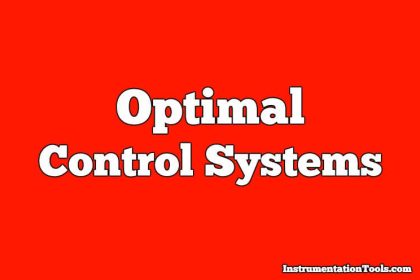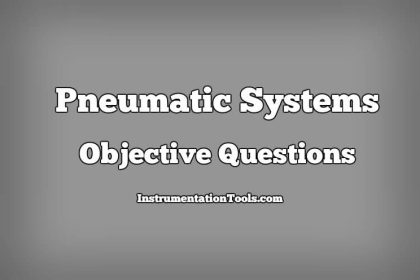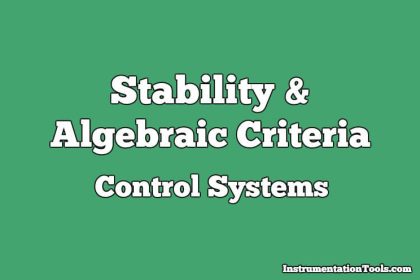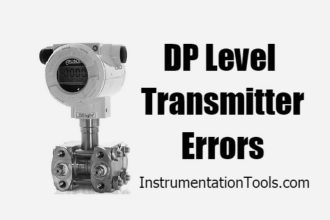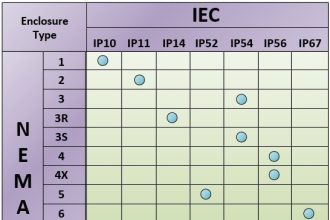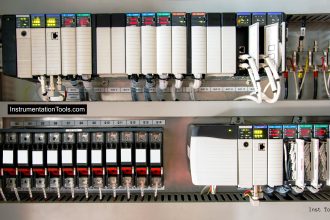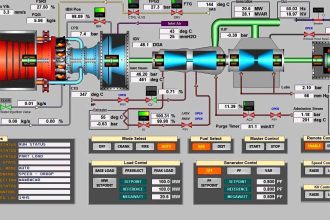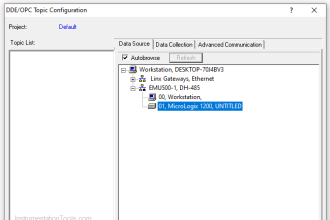Construction of Root Loci MCQ
1. With reference to root locus, the complex conjugate roots of the characteristic equation of the O.L.T.F. given below
G(s)H(s) =K(s+3)/(s+1)2, lie on
a) Straight line
b) Parabola
c) Circle
d) Semi-circle
Answer: c
Explanation: Complex conjugate roots of the characteristic equation of the O.L.T.F.lie on circle.
2. Determine the centroid of the root locus for the system having G(s)H(s) = K/(s+1)(s2+4s+5)
a) -2.1
b) -1.78
c) -1.66
d) -1.06
Answer: c
Explanation: Roots of the open loop transfer function are -1,-2+j, -2-j then centroid =Σreal part of open loop pole-Σreal part of open loop zeroes/P-Z
Centroid =(-1-2-2)-0/3 =-5/3 =-1.66.
3. The loop transfer function of an LTI system is G(s)H(s) =K(s+1)(s+5)/s(s+2)(s+3). For K>0, the point on the real axis that does not belong to the root locus of the system is
a) -0.5
b) -2.5
c) -3.5
d) -5.5
Answer: c
Explanation: The points present on the root locus are right to the odd number of poles and zeroes.
4. The angles of asymptotes of the root loci of the equation s3+5s2+(K+2)s+K=0 are:
a) 0° and 270°
b) 0° and 180°
c) 90° and 270°
d) 90° and 180°
Answer: c
Explanation: P-Z =2
Angle of asymptote = (2q+1)180°/P-Z
Angle are 90° and 270°.
5. The intersection of asymptotes of root loci of a system with open loop transfer function G(s)H(s) = K/s(s+1)(s+3) is
a) 1.44
b) 1.33
c) -1.44
d) -1.33
Answer: d
Explanation: The intersection of asymptotes of root loci of a system is same as the centroid which is centroid =Σreal part of open loop pole-Σreal part of open loop zeroes/P-Z.
Centroid = -4/3=-1.33.
6. If a feedback control system has its open loop transfer function G(s)H(s) = K/(s-2)(s2+3s+5) has the root locus plot which intersects the imaginary axis at s =0, then the value of K at this point will be
a) -5
b) 10
c) 5
d) -10
Answer: b
Explanation: The intersection point on the imaginary axis at s =0 is obtained by Routh Hurwitz criteria making s^0 row zero and getting the value K = 10.
7. The open loop transfer function of the feedback control system is given by G(s) =K(s+3)/s(s+4)2(s+5)(s+6). The number of asymptotes and the centroid of asymptotes of the root loci of closed loop system is
a) 4 and (-4,0)
b) 3 and (-12,0)
c) -4 and (-4,0)
d) -3 and (-12,0)
Answer: a
Explanation: Number of Poles = 5
Zeroes =1
Asymptotes =P-Z =4
Centroid =Σreal part of open loop pole-Σreal part of open loop zeroes/P-Z
Centroid = -4-4-5-6+3/4 =-4.
8. The characteristic equation of a control system is given as 1+ K(s+4)/s(s+7)(s2+2s+2)=0. The real axis intercept for root locus asymptote is:
a) -2.25
b) -1
c) -1.67
d) 0
Answer: c
Explanation: Real axis intercept =centroid
Zero =-4 and Pole = -7, -1, -1, 0
Centroid =Σreal part of open loop pole-Σreal part of open loop zeroes/P-Z
Centroid = -7-1-1+4/3 = -1.67.
9. The OLTF of a unity feedback system is K(s+2)(s+4)/(s+5)(s+6) the angle of arrival of the root loci as s =-2, and s =-4 respectively are:
a) 0°,180°
b) 180°,0°
c) 90°,180°
d) 180°, 90°
Answer: b
Explanation: As it is type zero system therefore the angle of arrival can be either 180°, 0°.
10. The characteristic equation is s3+14s2+(45+K)s+K =0, centroid is located at (-x,0) then the value of x is ____________
a) 1
b) 2
c) 3
d) 4
Answer: b
Explanation: Differentiating the equation of K with respect to s and equating it to zero.Breakaway points are -2, -2+1.414j,-2-j1.414. so 2 is complex breakaway point.

